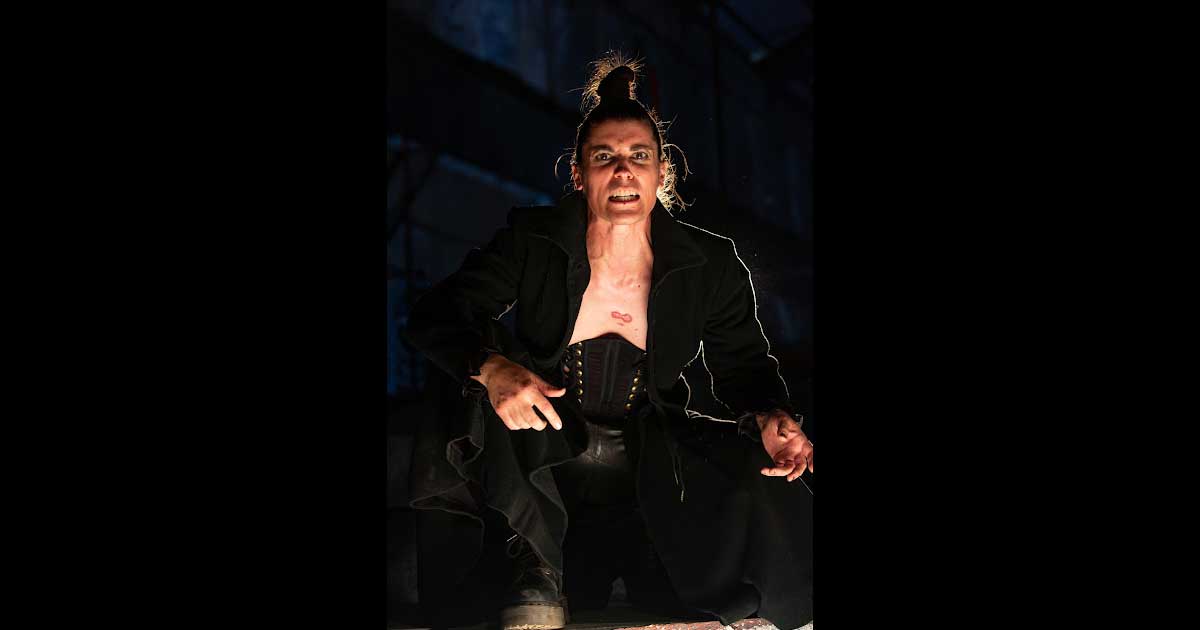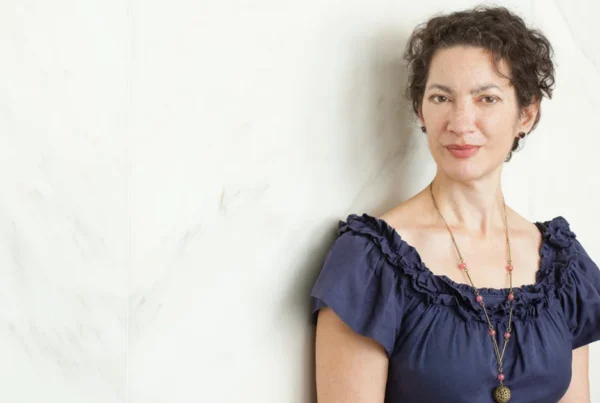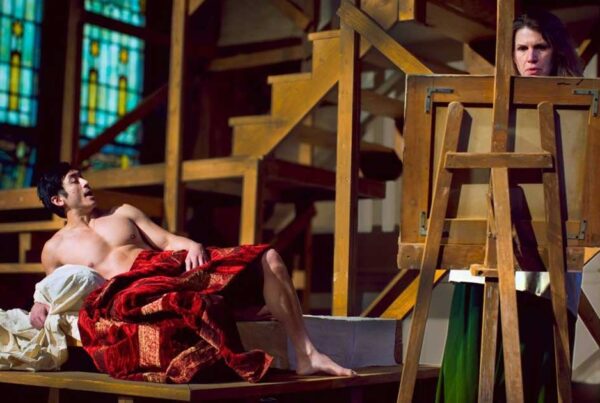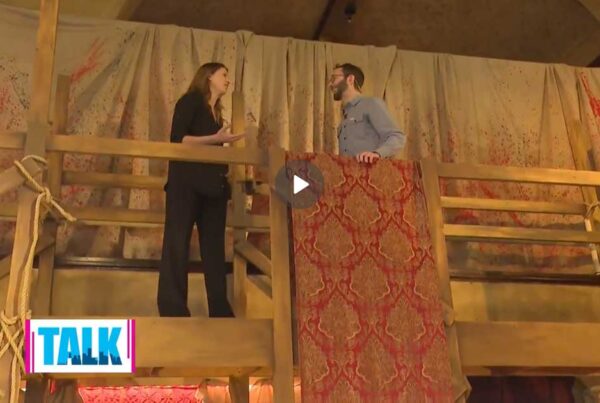
Pittsburgh Owlscribe – Want to Know More? Check out the Following Q&A with Artistic Director Karla Boos.
Known for producing plays that challenges its audiences, Quantum Theatre is doubly famous for staging them in some of the most unlikely spaces all over the city.
Like a frog jumping from lily pad to lily pad, the theater without a permanent home has set up shop at places as varied as the Recycling Building in Pittsburgh’s Strip District, the Mellon Park Rose Garden, Trinity Cathedral, Temple Rodef Shalom, the Schenley Park Ice Skating Rink and the Frick Park Lawn Bowling Green.
Currently, the adventurous, peripatetic company is in Rankin, where much of Pittsburgh steel making prowess was once located, in the historic and massive Carrie Furnace. The monstrous industrial remnant is the backdrop for Elsinore, the Danish castle once home to Prince Hamlet. The setting provides an atmospheric. moody experience unlike any previous Hamlet you might ever have seen.
Artistic director Karla Boos has edited Shakespeare’s longest play to allow for a manageable 2 hour and 15-minute outdoor performance with a 20-minute intermission between acts. Adding to the unique ambiance is lighting designer C. Todd Brown’s soothing hues of violet and azure along with brilliant white spotlighting that showcases costume designer, Susan Tsu’s glorious costumes, graced by a skillfully proficient cast of actors.
Quantum’s exceptional staging of Hamlet runs through August 27. Tickets can be had by phoning 412-362-1713 or www.quantumtheatre.com/hamlet. If you’d like to know more about the production, check out the following Q&A with Quantum’s artistic director, Karla Boos.
Q: I assume not having a permanent home does create extra challenges for your artistic and creative team, but what other issues are involved in moving from venue to venue with each new production? Are there any advantages that come with this arrangement, and do you often wish for a permanent stable place to perform?
A: While I often wish it was a little easier, I don’t wish for a permanent home, we long ago fell in love with the freedom to choose audience configuration, proportions, texture (old and gritty, slick and new?) By we, I mean all the artists, designers, directors, and even all Quantum’s administrative people who communicate about our mission and sell the tickets – for example we can choose Rodef Shalom for The Flying Lovers of Vitebsk (about Marc and Bella Chagall) because it’s a place of such meaning – not just for Jewish people but all people of Pittsburgh. Can’t say enough about what a site may contribute to the experience of the play.
Q: Hamlet is the second Shakespearean tragedy you’ve staged at the Carrie Furnace. Are there any attributes about the site that complement the bard’s narrative or your staging and production designs? And, just curious, I’m wondering if you considered doing Hamlet elsewhere and what other sites may have been under consideration?
A: We chose to do Hamlet and do Hamlet at Carrie Furnace together. It is, in a sense, a follow-up to King Lear, with Jeffrey directing it, who played Lear. Of course, we’re using a different part of the vast site, and design is very different, but we expect people to remember and that adds a layer to their experience. Carrie Furnace is always going to be about power, isn’t it? Power that wasn’t going to last forever.
Q: Naturally, the title character is always of crucial interest. How did you come about to choose multidisciplinary transgender artist Treasure Treasure for the role?
A: An easy question to answer. When Treasure spoke Hamlet’s text in an audition for me and Jeffrey, though we had marvelous contenders, there was a special, riveting connection. We hadn’t thought about a transgendered person in the role. But she was it, and I think anyone who sees her will feel as we did.
Q: I understand that you originally planned to stage Hamlet inside the site’s Power House building, but subsequently made a decision to move everything outdoors, even though the set construction was finished or nearly completed. Why did you decide to go outdoors, how soon before opening night did you decide to make the change and how much reconfiguration and extra effort was required?
A: It was a herculean effort to move it, and we’re all so grateful to Quantum’s amazing staff and crew for accomplishing it! One week into rehearsals, the inside space was finished enough to start working on the set and after a day or two of that we just concluded it wasn’t best. Everyone moved super quickly – Rivers of Steel in letting us explore an alternative, and then as I say, the crew on speed drive. Theater is a live art; Quantum has an extra dose of ‘liveness.’ We face the unknown pretty fearlessly and sometimes the reward is great. This was worth the work.
Q: Despite of the venue’s industrial, blue-collar setting, I see that the costumer created some interesting, colorful and, in some cases, regal outfits. Did you and she ever consider going modern or at least to some design motif that ties in with the post-industrial ambiance?
A: We talked a lot about the fact that this is a ghost story, and a timeless one at that. We believe we’re built a show that feels very contemporary in its relevance. Susan Tsu is so sophisticated an artist, it’s not about ‘period’ or ‘modern’ for her – it’s much more complex, and I think you feel her great experience and complexity in the results. We’re blessed in her, Tony Ferrieri (scenic), C. Todd Brown (lighting), and Sartje Picket (composition and sound) – and they all work together and with the director to end where they do.
Q: I was most impressed with Saige Smith’s rock-laden rendition of her Act Two lament. Not only did it come as a complete surprise, but the composition by Sartje Pickett provided an entirely new dimension to the narrative flow. I’m curious to know how much input you and director Jeffrey Carpenter might have given to the composer.
A: Jeffrey and Sartje were talking for months and months, a dissonant, rock-laden score was an influence on the whole project’s development. Saige is a dream to realize those songs as Sartje arranged them, and we have Dave Mansueto, Treasure herself – lots of musicians in the cast!
Q: Something that completely surprised me is the excellence of the fight scene at the end of the play. Compliments are in order for the realism fight director, Thom Delventhal, elicited from Treasure and Brenden Peifer as Laertes. Would you happen to know how quickly Treasure picked up this particular skill?
A: I’m like you, full of admiration for the fight, thank you for complimenting it and I’ll pass it to Thom, Treasure, Brenden, and also Brett Mack, who is the repiteur, helps them really get it into their bodies, sees it from all the angles, etc. These are accomplished, physical people, but they had to work very hard to make the fight this good – among other things like figuring out Hamlet and Laertes!
Q: You were responsible for editing the text. What was your main modus operandi, your goal, and how challenging was the process for you?
A: I’m very proud of my edit. I wanted a bit more than two hours running time and that meant cutting about half the play. There are a few speeches I didn’t touch, and I wanted all the marvelous things people know to be in there, so my edits are minute, it was very hard. It had to make great sense, preserve meter, and feel comfortable in the actors’ mouths. It took me a solid 6 months, speaking it aloud the whole time. It was what I wanted to contribute, as an artist, to this Hamlet.




